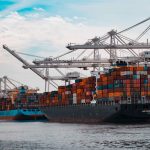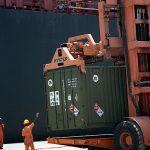Shipping News Roundup – Freight Rates, Carrier Reliability, & ILWU
Want to know what’s happening with international shipping right now? You’re in the right place.
Today’s post hits top international shipping news stories affecting shippers’ import and export operations and bottom lines right now.
Freight Rates Hit Bottom?
After the meteoric rise in freight rates during the pandemic, which had shippers asking how much higher freight rates could possibly get, those freight rates finally started falling. Falling freight rates has been the overall trend for the last year. As freight rates on many routes hit pre-pandemic levels and some even dropped under that, the new recurring question is when will freight rates bottom out?
The answer may be that they already have bottomed out. Lars Jensen points to data to support idea we’ve already hit bottom in a Journal of Commerce (JOC) article:

Looking at freight rate developments over the past couple of months, the data supports that we might have reached the bottom of the market. Of course, there are no guarantees that carriers will not suddenly lapse into a more destructive price war, but the present data does not support that this is currently happening.
…
The China Containerized Freight Index (CCFI) is useful when looking at long-term trend developments….
As the market was reaching a crescendo in early 2022, I presented an outlook at the Journal of Commerce’s TPM22 conference in Long Beach pointing out that when the market normalized, we should expect a reversal to the long-term trend from before the pandemic. The CCFI index showed a gradual slow decline in the period from 1998-2014. This was abruptly lowered as a result of the great price war of 2015-16, but the consolidation in the industry meant that by the end of 2019 the rate levels were gradually reversing to the long-term trend. At that TPM22 conference, it was also predicted that the return back to normality would likely undershoot in the sense that rates would drop too far and then rebound back up.
Fast forward to the end of April 2023. The overall CCFI index was back to the long-term trend in the first week of March 2023 and bottomed out in mid-April with, potentially, a slight increase in the last week of April.
If this analysis is narrowed specifically to the Pacific trade from China to the US West Coast, the long-term trend line was reached in the first week of January 2023 and the bottom was reached in the third week of March, having stayed more or less stable at that level since.
But then it should be noted that the CCFI includes contracts, and this index tends to lag the changes seen in the more volatile spot rates.
If we stay with the China to US West Coast market, the Drewry WCI spot index has seen a rate decline from January to April which is mainly in line with what one could expect from the seasonal impact from Chinese New Year. The increase seen in recent weeks also matches the Chinese New Year seasonality as there is typically a pre-peak season bump at exactly the timing and magnitude that we are currently seeing….
…
Fundamentally, the data presently supports the notion that the market has, overall, reached the low point and is about to rebound slightly to be brought back in line with the long-term trend.
However, Jensen does point to two factors that could still lead to a drop and, thus, a bottom yet to be seen. One is a price war between carriers, which he believes the data supports is not happening. The other is “a severe undermining of the supply/demand balance,” which he admits is already the case “to some degree.”
I’ve written about the supply/demand imbalance quite a bit in this blog. With economic uncertainty and remaining overstock of goods for many retailers, shipping demand remains much lower than it was in the wake of lockdowns and stimuli checks. Add to that an infusion of capacity in the industry with new ships being delivered to the industry, and there remains downward pressure on freight rates.
I have written that I expect demand to tick up a bit during peak season. For Jensen, the litmus test for the international shipping industry is whether or not there will be a 2023 peak season. As I’ve predicted previously in this blog, I believe there will be a peak season this year. However, I expect it to be that of a weaker year’s peak season. Therefore, I expect freight rates to increase some in the upcoming months. However, that doesn’t mean the overall downward trend in freight rates would have to be over.
If the economy does as poorly as many expect it to through 2023 and into 2024, then the freight rate market likely hasn’t actually bottomed out yet.
Reliability Continues to Improve with Declining Cargo Volumes
Part of me wanted to add “duh” to the above subtitle. The reliability of cargo ships arriving when and where they’re supposed to has continued to improve with lower demand and less port congestion. Still, goods arriving to ports when they are supposed to is an important thing for shippers and a news story worth including in this roundup.
Here’s the gist from a JOC article published yesterday:
The on-time performance of container ships improved globally and on the North American trades in March as cargo volumes declined and supply chain bottlenecks continued to ease, according to Sea-Intelligence Maritime Analysis.
Global schedule reliability increased 2.4 percentage points to 62.6% month over month and was a “staggering” 26.8 percentage points higher compared with March 2022, according to the Global Liner Performance report released over the weekend by Sea-Intelligence.
Let’s be clear, reliability from ocean freight carriers in the international shipping industry isn’t good. I don’t know of a time when it has been good. Ocean freight carriers are notoriously unreliable when it comes to ships arriving on time. Of course, there are many factors beyond carriers’ control that contribute to that. When there is a bottleneck or congestion at one port, it can easily delay ships and ripple through global supply chains.
However, there is plenty of responsibility shipping lines carry for this problem too, but accountability is lacking in the ocean freight sector of the international shipping industry. I doubt there are many industries where the expectations and bar for reliability are so low that just managing to deliver on time more than half the time is considered good. But that’s basically what we’re looking at when it comes to ocean shipping.
The JOC gave more reliability data that would likely be of interest to U.S. importers and exporters:
In the Asia-US West Coast trade lane, month-over-month schedule reliability in March increased 12.2 percentage points to 42.3%. That was also up from the 19.6% on-time performance in March 2022.
On the Asia-East Coast trade lane, month-over-month reliability was up 5.4 percentage points to 44.5% and significantly higher than the 19.8% on-time performance recorded in March 2022.
Of course, this increased reliability correlates with decreased cargo volumes and the clearing up of supply chain bottlenecks, which is pointed out in the JOC article.
Trans-Atlantic Freight Rates Falling
One area where freight rates have not fallen as much this year as everywhere else is on trans-Atlatic routes. However, that is now changing, according to a FreightWaves article by Greg Miller.
Freight rates are coming down there too, which could lend toward the argument we haven’t really bottomed out when it comes to freight rates yet.
Here’s some of what Miller shared Friday on the topic of trans-Atlantic freight rates:
The trans-Atlantic westbound trade has been a star performer for container lines over the past year, a bright spot amid a global slide. Europe-to-U.S. rates have been an outlier, staying far higher than those in the trans-Pacific trade and — until recently — far exceeding pre-COVID levels.
That premium is still there, but it’s shrinking fast. Europe-East Coast spot rates continue to steadily decline, following the same pattern previously seen in the other mainline trades. The only difference is a time lag.
Import data explains the belated fall of the trans-Atlantic. The Asia-U.S. trade is dominated by consumer goods. These fell first. The Europe-U.S. trade is primarily driven by building supplies and secondarily by beverages, furniture and mechanical equipment (including auto parts).
Construction-goods demand held up longer than consumer-goods demand. Now the construction side is sinking.
The Freightos Baltic Daily Index (FBX) put average Europe-East Coast rates at $3,081 per forty-foot equivalent unit on Thursday, down 44% year to date.
The premium versus pre-COVID rates on this trade has shrunk to $1,022 per FEU.
At the beginning of this year, the spread was over triple that. In early October, the premium versus pre-COVID rates was six times higher than it is now, according to FBX data, at over $6,100 per FEU.
A comparison of the five-year FBX Europe-East Coast rate curve to the FBX global composite (a composite of all trades covered by FBX) shows how the trans-Atlantic westbound trade crested later during the boom era and is almost exactly paralleling the global trend downward with a delay.
If the trans-Atlantic rates are really following the same path just later that the trans-Pacific ones have gone through, we should see those rates coming down for a while. However, shippers are still diverting goods from West to eEast Coast ports whenever possible because there is no end in sight yet for the ILWU contract negotiations on the West Coast ports. That increase in cargo going through East Coast ports, especially if we do see a legitimate peak season, could put some upward pressure on Trans-Atlantic mitigating some of the downward pressure from falling volumes from Europe. However, that downward pressure from reduced demand should be significantly greater.
ILWU Negotiations Latest
The week before last, the ILWU tried to put some positive spin on its contract negotiation situation by putting out a brief statement saying tentative agreements had been made between the union and its employers’, represented by the PMA. I wrote a full post about why that meant nothing. There was, however some meaningful news on the ILWU front last week.
Bill Mongelluzzo reported in a JOC article that a meeting took place between the ILWU and PMA last Monday:
A meeting taking place Monday between West Coast longshore labor and employer representatives to discuss a key issue involving nonautomated terminals at the ports of Los Angeles and Long Beach could result in a major hurdle being cleared on the road to a new coastwide contract. The gathering is taking place as negotiations over a new deal near the one-year anniversary of their May 10, 2022 start.
Sources told the Journal of Commerce that Local 13 of the International Longshore and Warehouse Union (ILWU) and the Pacific Maritime Association (PMA), which represents marine terminals and shipping lines, were meeting Monday to discuss the union’s manning demands for conventional terminals in Southern California. Coming to an agreement on that issue would enable the ILWU and PMA to move on to other big issues such as wages and retirement benefits, the sources said.
Talks between the two sides are being held up by the insistence of Local 13 to increase manning on top-handlers and other equipment that is used primarily at conventional container terminals in Los Angeles–Long Beach, sources said. Although the manning requirements will apply only to Southern California, they must be agreed to by the ILWU and the PMA in the coastwide contract.
After effectuating a full halt at the Ports of Los Angeles and Long Beach leading into Easter Weekend, ILWU Local 13 continued labor action slowing operations at the nation’s busiest port complex. Mongelluzzo’s article included that the ILWU finally stopped this labor action before the meeting happened:
Several sources with knowledge of port operations in Los Angeles–Long Beach said recent ILWU job actions ceased over the weekend in advance of Monday’s negotiations….
The job actions taken by Local 13 over the past three weeks affected cargo handling and resulted in late vessel arrivals and departures at many of the 12 container terminals in Los Angeles–Long Beach, terminal operators said. According to the Marine Exchange of Southern California, vessel arrivals and departures at some terminals last week were running 12 to 24 hours late.
Unfortunately, there are no indications of serious progress being made between the ILWU and PMA, leaving shippers to worry negotiations will drag into the peak season and cause port disruption at the worst possible time of the year.





